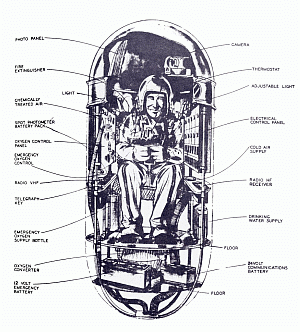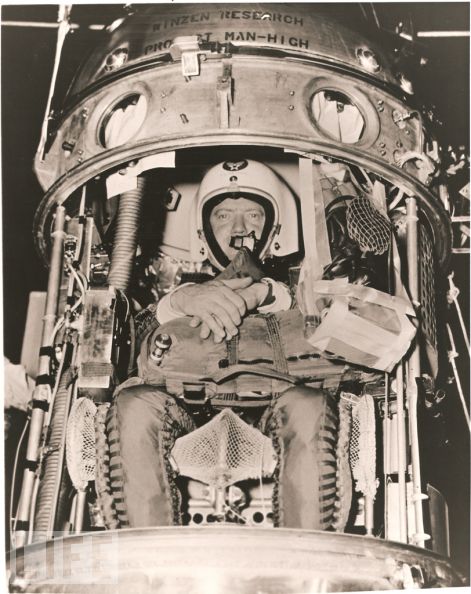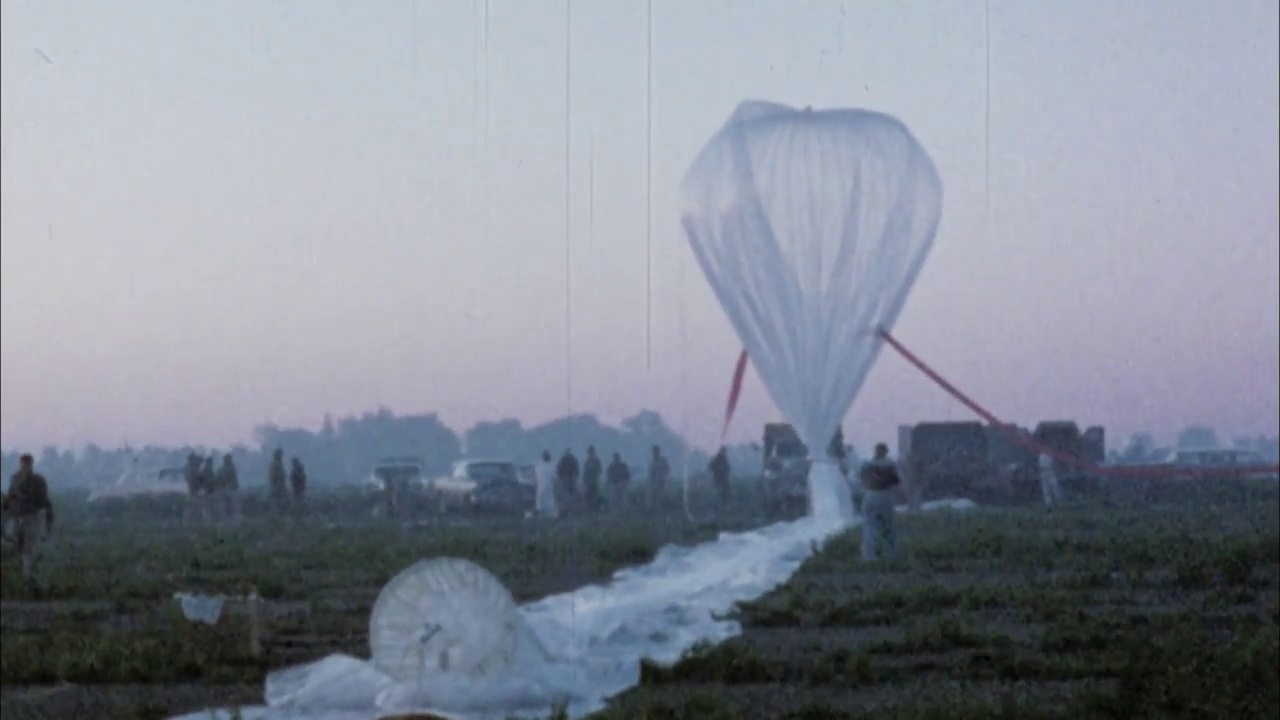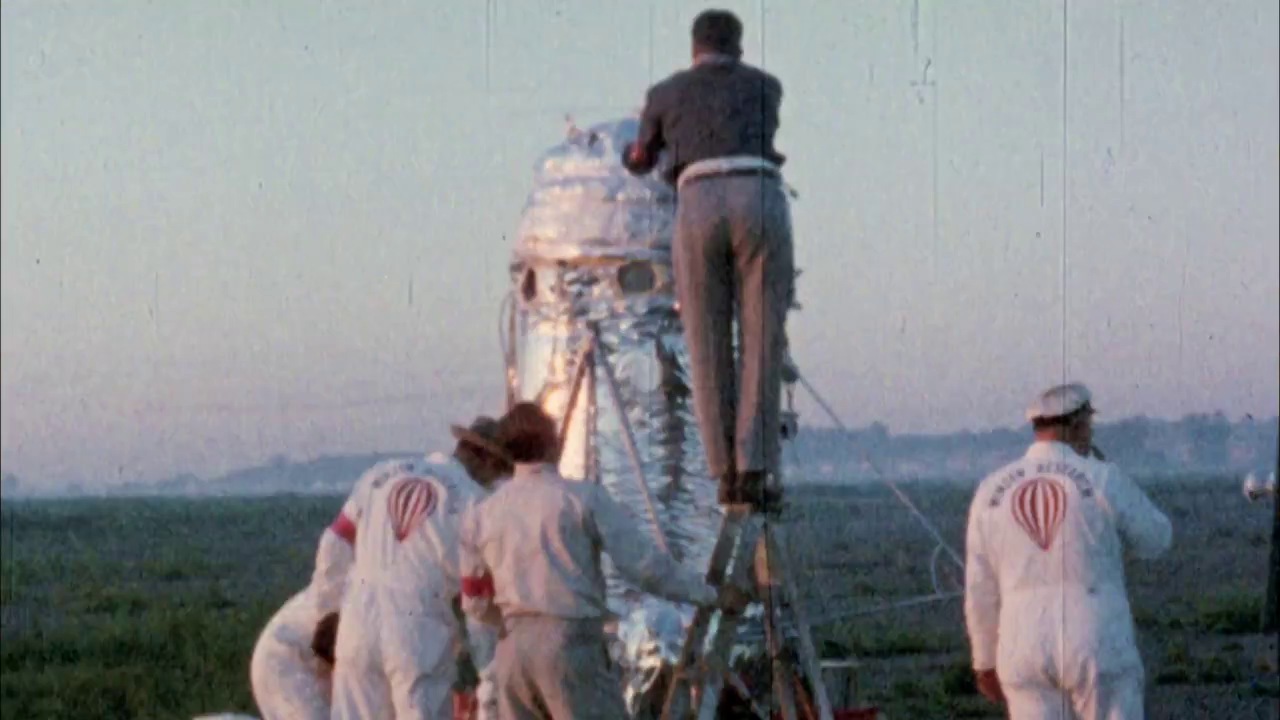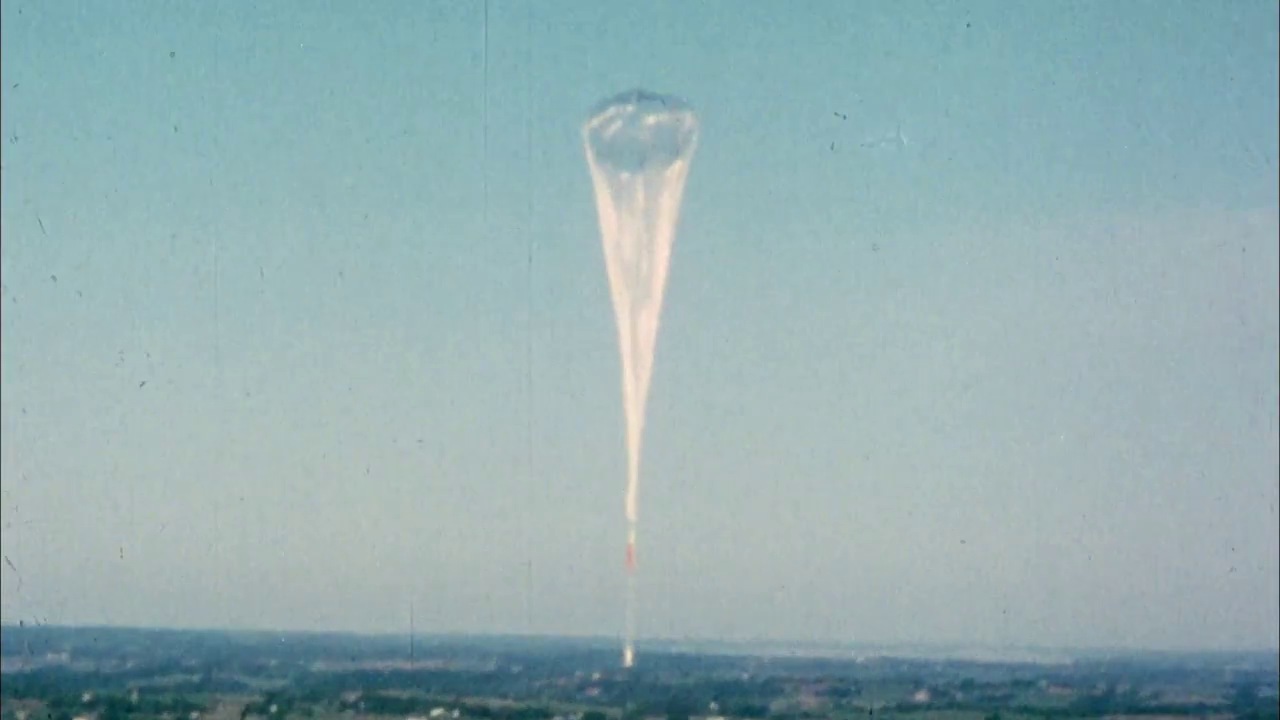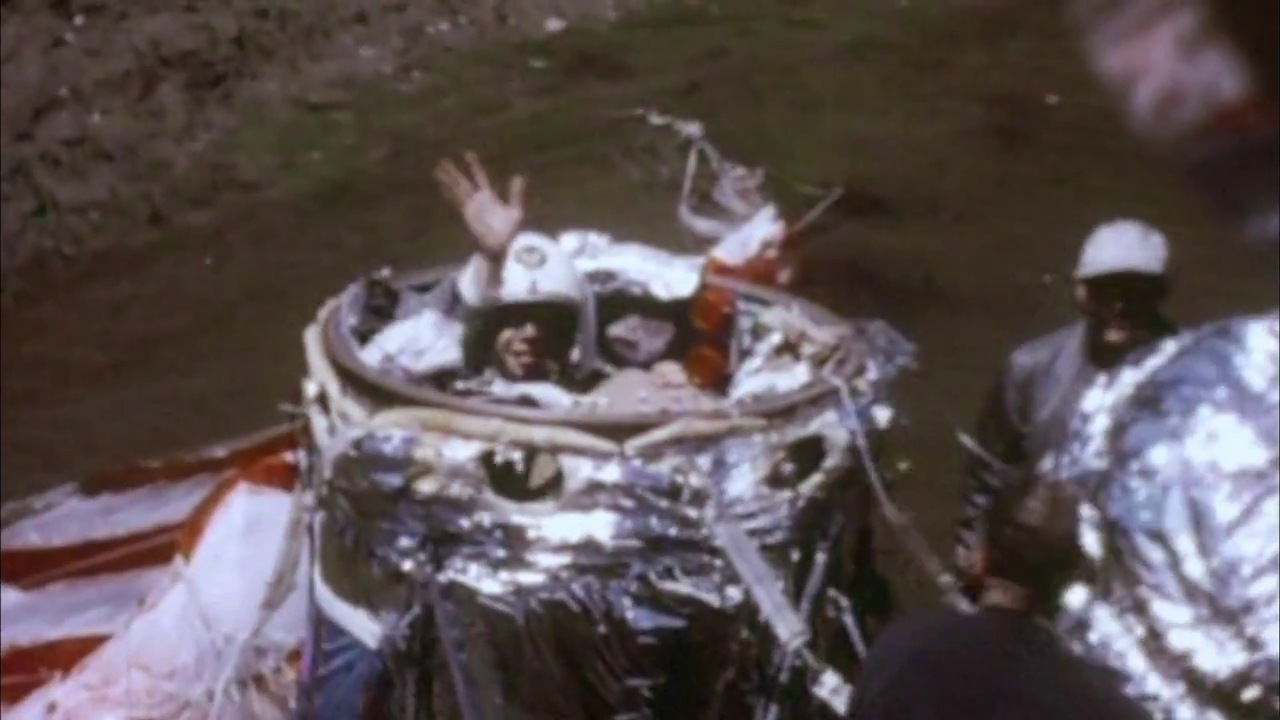Purpose of the flight and payload description
Project Manhigh was a United States Air Force balloon flight program designed to investigate the human factors of space flight by taking men into the stratosphere. Since space is considered a hostile environment, in the middle 50's the Air Force needed to know how humans could survive there and sought to discover more of the design principles for space capsules and how to study men and their reactions when in space. The collection of such data would permit intelligent planning of future space flight experiments.
Dr. John P. Stapp, who was then chief of the Aeromedical Field Laboratory, Air Force Missile Development Center, had approved the project at the local level and forwarded it through channels to obtain the necessary headquarters approval. Dr. David G. Simons of the Aeromedical Field Laboratory, was appointed the Air Force Project Officer.
Contracts for the construction of the balloon and capsule, the balloon training of the pilots and the launch support were let to Winzen Research Inc., Minneapolis, Minnesota. Planning was jointly conducted by Holloman AFB and Winzen personnel.
As the Air Force has always considered safety to be paramount, before men were allowed to ascend in the capsule, there were six unmanned flights to test all portions of the system. Also the pilot went trought a hard preparation including a parachute jump, a 24 hour claustrophobia test in the capsule, and numerous ground tests using the capsule climate control system, including a test in the high-altitude, low-temperature test chamber at Wright Air Development Center (now Wright-Patterson AFB).
The capsule used in the project was basically the same with some improvements from flight to flight (click over the top image to see a detail of it). It was an aluminum-alloy, hermetically-sealed unit 8 feet high and 3 feet in diameter, with hemispherically-shaped ends. The capsule was supported in an upright position by a tubular aluminum structure with various expendable equipment attached. This structure was especially designed to serve as a shock-absorbing system during landing operations. The capsule shell was constructed of three separate sections hermetically sealed together by two circumferential clamps. The turret casting, with six portholes, was the load-carrying member for almost all the internal structure and equipment.
The capsule was attached to an open, 40.4 foot extended skirt parachute with six suspension fittings positioned circumferentially around the turret casing. The parachute was, in turn, attached to the balloon by a stabilizing suspension system to retard any capsule oscillations during the flight.
The internal pressure of the capsule was the equivalent to that of 26,000 feet, line oxygen for the pilot's breathing and for cabin pressurization was provided by a 5-liter liquid oxygen converter and a 205-cubic-inch, high-pressure bottle. An emergency 90-cubic-inch bailout supply was installed in the personal parachute harness worn by the pilot. The sealed atmosphere in the capsule was chemically treated to remove carbon dioxide and moisture, and an external water evaporation cooling system was used to maintain the capsule temperature at a comfortable level.
Electrical and communications equipment was primarily installed inside the capsule. The main exception was the lead acid battery power supply. The batteries, mounted on the lower undercarriage ring and equipped with individual parachutes, were used as ballast when expended. In addition to the battery ballast, fine control was made possible by dropping steel shot through a metering valve mounted below the ballast container. A total of 246 pounds of ballast was carried on this flight.
The communications equipment for Manhigh I included a Very High Frequency (VHF) transceiver with an integral Visual Omni Receiver (VOR) receiver and a High Frequency (HF) receiver for voice communications. In addition, there was a telemetering transmitter for Continuous Wave (CW) transmission in the event of failure of the voice communications system.
Sequence cameras provided continuous recording of the flight progress, including photographs of the instrument panel and of the earth during the flight.
The pilot was in relative control of the balloon through an electrically-driven, 14 inch diameter, fail-safe gas valve located at the balloon apex wich could be activated from the capsule. It was used to release helium gas in order to decrease the rate of ascent, and initiate or increase the rate of descent.
Video of the launch of the balloon and landing
Details of the balloon flight
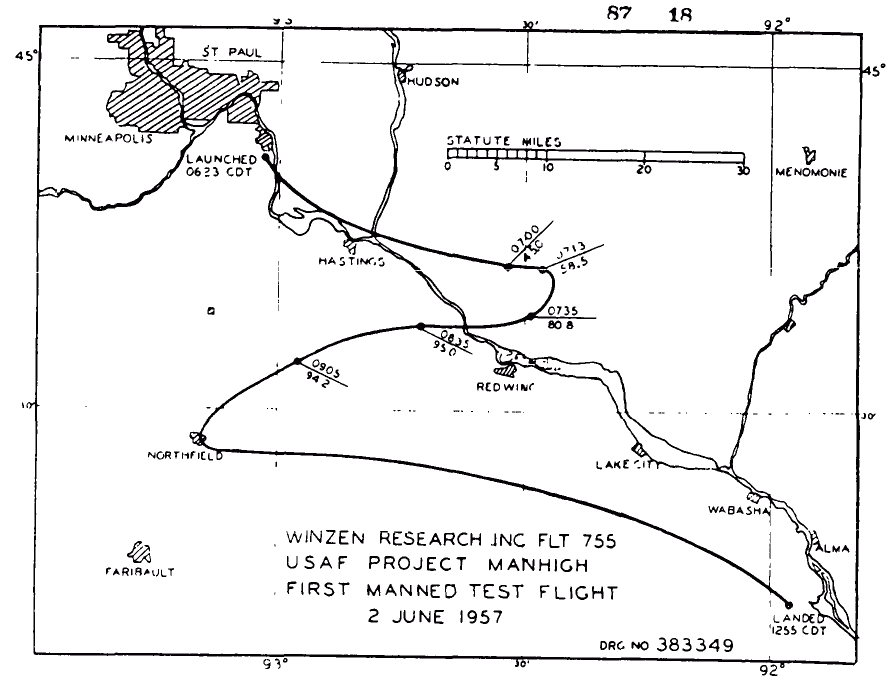
Balloon launched on: 6/2/1957 at 6:23 cdt
Launch site: Fleming Field Airport, South St.Paul, Minnesota, US
Balloon launched by: Winzen Inc. / HAFB
Balloon manufacturer/size/composition: Zero Pressure Balloon Winzen - 2.000.000 cuft - (2 mils)
Balloon serial number: 172.6-200-V-33
Flight identification number: WRI 755
End of flight (L for landing time, W for last contact, otherwise termination time): 6/2/1957 at 12:57 cdt
Balloon flight duration (F: time at float only, otherwise total flight time in d:days / h:hours or m:minutes - ): ~ 7 h
Landing site: Near Indian Creek, Minnesota, USA
Campaign: MANHIGH
Payload weight: 1012 lbs
Overall weight: 2166 lbs
This first flight of the MANHIGH project was piloted by Captain Joseph W. Kittinger, a young but highly experienced jet pilot assigned to the Flight Test Division of the Air Force Missile Development Center.
At 23:00 Central Daylight Time (CDT) on 1 June 1957, preparations begun at the Winzen Research plant in Minneapolis where Captain J. W. Kittinger received his last preflight physical examination prior to donning his partial-pressure suit and the instrumentation for measuring his physiological reactions during the flight. During the period of Captain Kittinger's preparation for his flight, the capsule, which would be his laboratory, was also being prepared. The liquid oxygen system was filled, and the chemicals were placed in the air regeneration unit. The electrical system and communications equipment were given a final oprational check.
At 00:30 CDT on 2 June 1957, Captain Klttinger entered the capsule, and again final checks were made to be certain that the equipment was operating properly. The capsule was sealed and then checked to make certain that it was pressure tight. The nitrogen content of the capsule was reduced by using a flushing procedure in which helium was used to replace the nitrogen in the capsule atmosphere. The purpose of this denitrogenation procedure was to reduce the possibility of bends in the event of an instantaneous decompression of the capsule at extremely high altitude. Preparations were completed at 3:30 CDT on 2 June 1957 and the capsule was transferred by truck to Fleming Fleld arriving there at 04:20 CDT. The flight preparations commenced inmmediately.
The pre-launch activities proceeded according to plan. The balloon was inflated and all flight equipment was installed. At 6:20 CDT all preparations were complete, the surface winds were peaking at approximately two knots, and synoptic meteorological conditions were ideal for the anticipated flight. At 6:23 CDT the balloon was released from the restrain rollers of the launching platform, and as the balloon ascended slowly, the capsule was lifted into the air.
At the time of launching, there were a number of tracking and photographic aircraft in the air. Communications at the command post were maintained during the initial portion of the flight by means of a portable VHF transceiver. Approximately 20 minutes after launch Captain Kittinger advised that he was going to check the other channels on the VHF communications equipment. As he turned the channel selector knob on the transceiver, a mechanical failure of the selector resulted in his being unable to determine the frequency to which the transceiver was tuned; thus he was unable to transmit voice communications throughout the remainder of the flight. His only trsnsmissions from this time on were accomplished by using the physiological and altitude telemetering HF transmitter as a morse code transmitter. The HF voice receiver was still operating properly, and he was able to read ground instructions. However, this became difficult during the later stages of ascent because of the proximity of a commercial broadcasting station that was transmitting on a wave length near Captain Kittinger's HF receiver wave length.
The breakdown in VHF communications needed a change in tracking procedures, since the CW transmissions from the capsule were being effectively received only at the Winzen Research plant. This information was relayed by telephone to the flight center at Fleming Field, with a resultant delay in obtaining critical information concerning the status of the flight operation.
Soon after launch it became apparent to Captain Kittinger that the capsule internal pressure was responding very slowly to the change in altitude. Inasmuch as the pressure response rate had never been experienced under actual flight conditions, it was necessary for Captain Kittinger to withhold any evaluation until it could be determined whether or not the capsule pressure would drop to the anticipated level. The loss of communications on the VHF transceiver resulted in a lengthy delay in reporting this problem. The first indication of impending trouble was received on the ground at 8:07 CDT when Captain Kittinger reported that his liquid oxygen supply was down to two liters remaining. This was confirmed, and the command helicopter was called back to Fleming Neld so that Lt.Col. David G. Simons, Colonel J. P. Stapp, and Otto. C. Winzen could discuss the situation. It was necessary to obtain more information from Captain Kittinger before evaluation of the problem was possible.
During this period, the balloon was floating at its ceiling altitude of 95,200 feet. The speed of the oxygen supply depletion indicated that the fault was in the cabin pressure controller, thus at 8:54 CDT decision was made to start the descent.
In an attempt to establish more direct contact with the capsule, the ground control function was transferred to the C-47 aircraft. At approximately 10:00 CDT, Captain Kittinger was advised to switch his oxygen supply to the pressure suit in order to conserve the remaining oxygen. This procedure definitely established that the cabin pressure controller was responsible for the excessive loss of oxygen; therefore, by closing the vent valve from this unit, it was possible for Captain Kittinger to resume the normal capsule atmosphere breathing procedure - manually replenishing the oxygen through the constant flow valve as required.
The cloud cover had by this time obscured the balloon from view of the C-47, and the command function was transferred back to the Winzen communication post at the company plant. The C-47 remained on the ground until 11:30 CDT, at which time Captain Kittinger had descended to 53,000 feet. At 12:15 CDT, Captain Kittinger reported that he had descended through the tropopause. Further attempts to re-establish VHF communications were unsuccessful, and shortly after 12:30 CDT, the balloon was sighted below the clouds. It was traveling in an ESE direction from a point directly south of Belle Plaine, Minnesota. The descent rate of the balloon was retarded by dropping part of the external batteries on individual parachutes.
Despite high surface winds and the heavily wooded nature of the terrain, the landing made by Captain Kittinger was executed with commendable control. The capsule passed over the tree tops and settled into a small clearing, landing at 12:55 CDT on the bank of Indian Creek just north of Weaver, Minnesota. At the instant of contact, the balloon was released, and the capsule toppled into the shallow water of the creek. Inmmediately after the landing, the two helicopters landed in the clearing and assisted Captain Kittinger from the capsule.
Postflight examination revealed that the pressure supply line and overboard vent line to the cabin pressure regulator had been crossed during installation. That resulted in the oxygen supply being dumped outside rather than inside the capsule. In spite of the numerous tests performed on the ground, the operating characteristics of the regulator were such that the error was not discovered.
A famous and funny incident occured in this flight when the decision was made to terminate the flight. Kittinger received the orders from the ground control center and he was not very happy with the decision, so he replied them using the morse code with his infamous phrase "Come Up and get me".
After the flight he was awarded the Distinguished Flying Cross.
External references
- Touching Space: The history of the project MANHIGH a Book wich offers the most comprehensive history of the project by Gregory Kennedy
- 50th anniversary of a forgotten space mission: Project Manhigh at The Space Review Magazine
- A life in pictures: Joe Kittinger Balloon Life Magazine
- Come Up and Get Me: An Autobiography of Colonel Joe Kittinger book by Craig Ryan
- History of research in Space Biology and Biodynamics 1946-1958 Air Force Missile Development Center, Holloman AFB, New Mexico (1958)
- Manhigh Project Capsule on exhibition National Museum of the Air Force
- MANHIGH-I Flight Test Report,1957 (Winzen Research Inc.)
- Manned Balloon Capabilities for Astronomical Observations Publications of the Astronomical Society of the Pacific, Vol. 70, No. 412, p.69
- Prelude to Space TIME Magazine - Jun 17, 1957
- Profile of Joe Kittinger at Red Bull Stratos website
558If you consider this website interesting or useful, you can help me to keep it up and running with a small donation to cover the operational costs. Just the equivalent of the price of a cup of coffee helps a lot.

